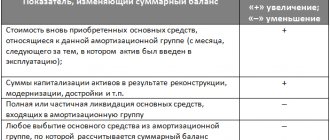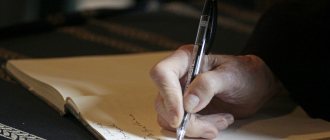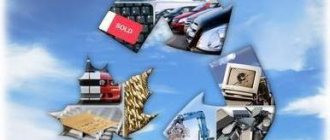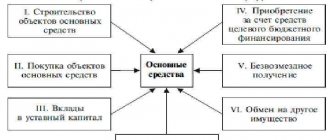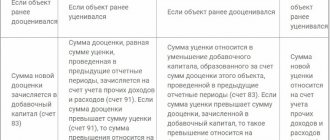Sale of fixed assets - postings
A company may decide to sell an OS for a variety of reasons, for example:
- Obsolescence of equipment;
- The company urgently needed money;
- Special equipment may soon break down, and it is easier to sell it than to repair it.
When selling fixed assets, the accounting entries will be as follows:
- D62 – K91-1 – reflection of the buyer’s debt for the sold fixed assets in the amount specified in the contract;
- D01, subaccount “disposal” - K01 – write-off of the original price of the fixed asset;
- D02 – K01, subaccount “disposal” - write-off of depreciation;
- D91-2 - K01, sub-account “disposal” - write-off of the residual price of the object;
- D83 – K84 – write-off of the amount of additional valuation for the sold fixed assets;
- D91-2 – To various accounts – write-off of costs for the sale of fixed assets;
- D91-2 – K68 – VAT accrual on the cost of the sold fixed assets;
- D51 – K62 – crediting payment from the buyer.
Methods of depreciation of fixed assets in accounting
Accounting uses four main methods for calculating depreciation, depending on the nature of the asset, legal regulations and its own interests.
With the straight-line method, the cost of an asset is written off evenly over its useful life. For example, if a machine is designed to last for five years, then 20% of its original cost will be depreciated each year.
The reducing balance method provides for the calculation of annual depreciation at the same percentage as with the linear method, but for the amount of the residual value rather than the original one. If we take the example of the same machine, then in the first year its cost will also decrease by 20%, but then the process will go slower (in the second year 16% will be written off, that is, a fifth of 80%, etc.). This non-linear method allows you to quickly depreciate fixed assets in the initial period of its operation, and then reduce its share in the cost of the product.
The third method is called “by the sum of numbers” , and is based on the addition of the numbers of the natural series that form the service life of the object. Despite the long name, it is quite simple. If we take the same example with a machine tool, its depreciation will occur at an accelerated rate in the first years of use:
This means that in the first year, depreciation will be one-third of the original cost. In the second year, 40% will be written off:
This method allows for accelerated depreciation.
And finally, the fourth method is that the cost of the fixed asset is transferred into the price of the manufactured product in proportion to the volume of its output. For example, it is known that on the mentioned machine it is possible to produce 10 million products over its useful life (5 years) without compromising quality. If 5 million units have already been made on it, then it should be depreciated by half.
Paragraph 5 of PBU 6/01 and Article 256 of the Tax Code of the Russian Federation clearly indicate that objects costing less than 40,000 rubles are not subject to depreciation.
Sale of fixed assets under an exchange agreement - posting
If a company sells an asset under an exchange contract, the transactions will be almost the same as for a regular sale. The first seven entries are exactly the same as in the previous case. After them the following entries are made:
- D08-4, 10, 41 – K60 – receipt of goods and materials under an exchange contract at the price of fixed assets to be transferred by the company;
- D19-1, 19-3 – K60 – reflection of VAT on assets received, in accordance with the seller’s invoice;
- D60 – K62 – the parties fulfilled their obligations under the barter agreement;
- D68 – K19-1, 19-3 – presentation of VAT for deduction.
What are the features of tax accounting for the disposal of fixed assets?
You should pay attention to the accounting procedure for implemented operating systems established by Chapter. 25 Tax Code of the Russian Federation. So, in accordance with paragraph 3 of Art. 268 of the Tax Code of the Russian Federation, a loss arising when the residual value of fixed assets exceeds the amount of proceeds from the sale of fixed assets should be accepted for the purpose of calculating income tax in equal shares over the entire remaining useful life. This feature of accounting for losses for income tax purposes creates temporary differences, which are reflected by applying PBU 18/02.
Example 2
The initial conditions are from example 1. At the same time, the remaining useful life of the OS is 37 months.
Let's determine the amount of loss 570,000 - (472,000 - 72,000) = 170,000 rubles.
The loss that Auto-Park LLC can evenly take into account monthly for the purpose of calculating income tax is 170,000 / 37 = 4,594.59 rubles. Starting from 2020, Auto-park LLC will reflect this amount as part of other expenses.
Thus, a temporary difference will arise in the accounting of the LLC - a deferred tax asset, reflected in August by posting Dt 09 Kt 68 - 170,000 rubles. In September, this amount will be reduced Dt 68 Kt 09 - 4,594.59 rubles.
Acquisition of fixed assets – postings
When a company acquires fixed assets, the accounting entries will be as follows:
- D08-4 – K60 – acceptance of sellers’ invoices;
- D08-4 – K60, 76 – reflection of costs: for information and consulting services, remuneration of intermediary firms;
- D08-4 – K66, 67 – reflection of interest on loans taken for the purchase of an object (interest accrued before the OS was put into use);
- D91-2 – K66, 67 – reflection of interest on loans that were accrued after the facility was put into operation;
- D08-4 – K68, 76 – reflection of the state. fees and registration fees associated with the purchase of the property;
- D08-4 – K68 – reflection of non-refundable taxes and customs duties;
- D01 – K08-4 – acceptance of an asset for accounting;
- D60, 76 – K51, 52, 55 – payment of sellers’ bills for the operating systems themselves and for the costs of their acquisition;
- D19-1 – K60 – reflection of VAT based on sellers’ invoices;
- D19-1 – K68 – reflection of the VAT paid when importing OS at customs;
- D91-2 – K60, 76 – reflection of negative exchange rate differences on debt for fixed assets;
- D70, 76 – K91-2 – reflection of positive exchange rate differences;
- D68 – K19-1 – VAT amounts are presented for deduction;
- D60, 76 – K91-1 – positive amount differences in debts were attributed to the company’s income;
- D91-2 – K60, 76 – negative amount differences are taken into account as part of the company’s expenses.
Accounting for depreciation of fixed assets and amortization
During operation, most fixed assets become obsolete. The exception is land resources, the service life of which is unlimited.
Monthly contributions to a special fund intended for updating the OS are made at the initial cost and are called depreciation. Wear calculation is performed based on two main parameters:
- initial cost;
- useful life of the object.
Determination of initial cost
The basis for the initial assessment of an asset related to fixed assets is the documented actual amount spent on putting it into operation. In addition to the purchase price, this concept includes direct costs:
- for delivery;
- preparation of the installation area;
- unloading;
- adjustment;
- overheads;
- other possible actions related to achieving serviceability.
If the fixed asset was purchased on credit, then in most cases it should be taken into account only for the principal amount (body), without interest paid. The exception is situations provided for by IFRS 23.
What determines the service life
The standard service life of the OS cannot be less than a year, but for each object it is determined individually, taking into account several factors:
- passport data and recommendations of the manufacturer;
- expected intensity of operation;
- specifics of maintenance;
- expected obsolescence;
- legal and other regulatory restrictions.
Types of depreciation of fixed assets
Complete or partial loss of a fixed asset’s useful operational properties, and, consequently, its depreciation, can occur for two main reasons:
Physical deterioration
Occurs as a result of exposure to harmful factors acting on an object during its use or storage. This concept includes a set of processes of friction, oxidation and other physical and chemical phenomena that accompany all material objects. The intensity of this type of wear is influenced by:
- rate of operation;
- quality indicators of an object that determine its durability;
- quality of fixed assets;
- external working conditions and technological features of the environment;
- personnel qualifications;
- thoroughness and timeliness of prevention and maintenance.
The degree of physical deterioration is determined by two methods:
- Expert, in which the condition of the object is assessed by specialists who compare objective parameters with reference ones.
- Analytical, taking into account the standard service life.
Obsolescence
It is expressed by a critical decrease in the efficiency of using the OS for commercial purposes due to conceptual obsolescence. A clear example would be the best computer produced in the mid-90s. Even if it has been sitting in a warehouse all the time in a packaged form, it does not meet today's requirements for computing technology.
It is customary to divide obsolescence into two types. The first form is associated with the reduction in cost of replacement analogues. In other words, the same object can now be purchased cheaper. The degree of obsolescence of the first form can be determined using the formula:
Where: MI1 – indicator of obsolescence of the first form; OSB – the cost at which an accounting unit is listed on the balance sheet; SALT is the amount that it will cost to restore or update a fixed asset in current market conditions.
The emergence of obsolescence of the second form is due to the advent of more advanced production methods and technologies. It is theoretically possible to work “the old fashioned way,” but the reproduction of a commercial product becomes less profitable, and its sale poses a problem due to competition.
The degree of obsolescence of a fixed asset of the second form is calculated using a formula expressing the relative increase in the efficiency of new means of production:
Where: MI2 – obsolescence of the second form; PNS – productivity of a new means of production in units of measurement accepted at the enterprise (for example, pieces per hour); PSS is the productivity of the old fixed asset in the same units.
Within the second form of obsolescence there is also a division into subcategories. He can be:
- Partial - if not all of its production value is lost. In some cases, an obsolete facility can be used in secondary process areas or operations with acceptable efficiency.
- Complete – when further exploitation entails losses. The outdated OS is awaiting dismantling and disposal.
- Hidden. There are no new, more productive fixed assets yet, but it is known that their development is underway.
- External. This subtype of obsolescence of the second form manifests itself under the influence of factors independent of the internal policy of the enterprise. For example, the production of manufactured products may be limited or prohibited by a decision of the authorities.
Regardless of the form of obsolescence, it is caused by technological progress. Some intangible assets (software, technical documentation, etc.) are also subject to it.
Free transfer of OS - wiring
When transferring property free of charge, the accounting entries for fixed assets will be as follows:
- D08-4 – K98-2 – reflection of the market price of fixed assets transferred free of charge;
- D08-4 – K60, 76 – accounting of costs for transportation, installation, installation and preparation of the object for use;
- D19 – K60, 76 – VAT is reflected at the market price of fixed assets;
- D01 – K08 – the received OS was accepted for accounting;
- D60, 76 – K51 – payment of expenses for the acquisition of OS;
- D68 – K19 – presentation of VAT for deduction.
Documentation of transactions with fixed assets
Accounting for fixed assets is based on primary documents and acts. They can be carried out on electronic or paper media in any form, in compliance with the required details. Instructions for accounting - Resolution of the State Committee on Statistics of the Russian Federation No. 7 of January 21, 2003.
Approved forms for primary accounting, to which additions can be made, are listed in the table:
| Form designation | Description of the action confirmed by the act |
| OS-1 | Acceptance or transfer of fixed assets, excluding real estate |
| OS-1a | Acceptance or transfer of real estate |
| OS-1b | Reception or transfer of several operating systems, excluding real estate |
| OS-2 | Internal OS relocation |
| OS-3 | Delivery and acceptance of OS after repair, modernization or reconstruction |
| OS-4 | Write-off of fixed assets, except vehicles |
| OS-4a | Vehicle write-off |
| OS-4b | Write-off of several operating systems, except for vehicles |
| 0С-6 | OS inventory card |
| OS-6a | Inventory card for a group of similar operating systems |
| OS-6b | OS inventory book |
| OS-14 | Receipt of equipment |
| OS-15 | Reception and transfer of installed equipment |
| OS-16 | Equipment inspection and defect report |
Accounting statements for fixed assets
During the entire period of use of the OS, all actions performed with it are covered by reporting. The accounting documents in which it is maintained are listed in the table:
| Document form | Purpose |
| Report on fixed assets | The object is characterized by depreciation group, estimated depreciation, initial and residual value, and capitalization date. Allows you to conduct analytical and synthetic analysis of the state of the operating system in the enterprise. |
| OS log book | Report on the movement of fixed assets, from the moment of registration to disposal. |
| OS accounting book | For enterprises operating under a simplified accounting system, it replaces inventory cards OS-6 and OS-6b. Filled out just like them. |
| OS comparison sheet (form INV-18) | Recording differences between inventory results and accounting data. Shortages are indicated by the sign “-”, surpluses by “+”. |
| Certificate of book value of fixed assets | Contains information about the book value of fixed assets at the time of the last report. May be for a third party or an internal sample. The OS balance sheet is requested by banks when considering a loan application. |
Orders relating to fixed assets
Due to the importance of fixed assets for each enterprise (they form the basis of its financial solvency), all actions with them (write-off, conservation, inventory, modernization, etc.) are formalized by orders of the organization’s top manager. They are completed on standard forms (additions are allowed). It is necessary to indicate the reason for this or that action (justification) and other details provided by the form.
Each of the orders is recorded in the INV-23 journal.
Sample order for fixed assets, in this case their inventory:
Download
Members of the inventory commission can be listed in the text of the document indicating their full names and positions or appointed by a separate order.
A sample order for the creation of a commission for the inventory of OS can be downloaded from the link:
Download
Title documents
Documents for the purchase of fixed assets are, as a rule, stored not in the accounting department, but with the chief lawyer, but they are also related to accounting. This is confirmation of the legal ownership of the OS.
For example, a purchase and sale agreement looks like this:
Download
An enterprise can also own property on the basis of agreements of gratuitous transfer, exchange and other title documents.
Liquidation of OS - postings
When liquidating a fixed asset, the postings will be as follows:
- D01, subaccount “disposal” - K01 - fixed assets written off at its original price;
- D02 – K01, subaccount “disposal” – write-off of depreciation accrued on a liquidated facility;
- D91-2 – K01, subaccount “disposal” - the residual value of the object is written off;
- D10 - K91-1 - capitalization of materials that were received due to the liquidation of the operating system;
- D91-2 – K76 – costs for work to liquidate the OS are written off;
- D19 – K76 – issuing VAT on work related to liquidation;
- D76 – K51 – payment for liquidation work was made from the account.
If the OS was sold
In order to correctly record transactions for the disposal of fixed assets due to sale, it is necessary to organize the following processes:
https://youtu.be/PSLPh0A4y98
- Write off the starting price
- Write off depreciated fixed assets
- Record the amount of proceeds received as a result of the sale
- Take into account the VAT amount
| DT | CT | Size | Primary documents | What does it display? |
| 01.09 | 01.01 | 450 | An act reflecting the acceptance and transfer | Initial cost |
| 02.01 | 01.09 | 120 | Depreciation | |
| 91.01 | 01.09 | 330 | After depreciation | |
| 62.01 | 91.01 | 390 | Write-off of sales revenue | |
| 91.01 | 68 | 59,5 | Fixation of VAT amount |
Since the sale of fixed assets is a transaction as a result of which the company makes a profit, the calculation and addition of VAT is required.
OS inventory - postings
Based on the results of the inventory, the following entries are made in accounting:
- D01 – K91-1 – capitalization of the surplus discovered during the inventory;
- D94 – K01 – reflection of the identified shortage;
- D73 – K94 – writing off the shortage to the guilty employee;
- D50 – K73 – payment of the shortfall has been made;
- D70 – K73 – withholding the deficiency from the salary of the guilty employee;
- D91-2 – K94 – writing off the shortage.
Similar articles
- Fixed Asset Accounting
- Account 01 “Fixed assets”
- Money
- Accounting for receipt of fixed assets
- Accounting for other income and other expenses
Guidelines for accounting for fixed assets
The procedure for accounting for fixed assets is regulated by the fundamental document - “Methodological guidelines for accounting of fixed assets”, approved by Order No. 91n of the Ministry of Finance of the Russian Federation dated October 13, 2003.
In addition, internal standards of the enterprise are also practiced, established within the limits of legislative restrictions. In particular, the accounting policy is determined by a special order, which once and for all (as long as the organization exists) specifies the rules for accounting, tax and financial reporting.
According to Article 1 of the Accounting Law, accounting policies are the principles, methods and procedures used by an enterprise in the process of preparing financial statements.
The order on accounting policy reflects not only the organization of accounting, but also the rules of accounting assessment.
The internal regulations also include the job description of the accountant for accounting of fixed assets (if such a position is provided for in the staffing table) or the chief accountant.
Provided reasons for disposal of fixed assets
An organization loses fixed assets for various possible reasons:
- moral and/or physical wear and tear of the property fund;
- destruction as a result of an emergency (accident, natural disaster, catastrophe, etc.);
- irreparable damage (intentional or accidental);
- theft of a fixed asset;
- loss of an object identified during inventory;
- completing a purchase and sale transaction, the object of which is OS;
- conclusion regarding the object of a gift or barter agreement;
- transfer to another legal entity or individual free of charge;
- the fixed asset has become a contribution or part of a contribution to the authorized capital of another legal entity;
- The redemption period has come for the property leased on a leasing basis.
ATTENTION! There may be other reasons for the disposal of fixed assets; the main condition for carrying out the procedure is the absence or impossibility of using the object based on the results of the next inventory.
If an object was simply moved between structural divisions within the same organization, this is not considered a disposal.


